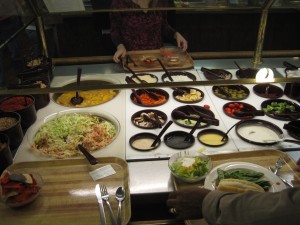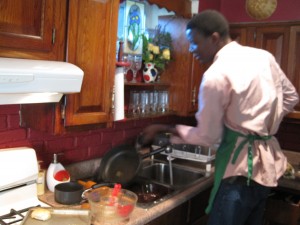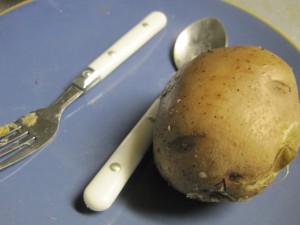 When is a soup a soup and a yam a yam? My concept of these two food items has definitely undergone a radical change in the past three months since I’ve been here. Well now that I think about it, there has been some gradual change in my perception of them, but not in the way that the United Forests of America has shocked this Nigerian ghoul into a different realization.
When is a soup a soup and a yam a yam? My concept of these two food items has definitely undergone a radical change in the past three months since I’ve been here. Well now that I think about it, there has been some gradual change in my perception of them, but not in the way that the United Forests of America has shocked this Nigerian ghoul into a different realization.
In the beginning, soup was red, peppery and totally fluid, except for pieces of meat, fish, shrimp or other animal flesh. Of course, soup was also vegetable cooked with crayfish, onions, spices, oil and some other nice stuff. And then I travelled out of my comfort zone and came across a few women to whom what I called “soup” was just pepper stew. Yea, if you’re an Igbo Nigerian, you’re probably grinning by now in agreement. I discovered from those women from South Eastern and South Southern Nigeria, and from an Igbo roommate while in the University that what I called soup (by the first definition) was nothing but ofe n manu (stew filled with palm oil, or something like that). We had many bouts of argument about what made a “soup” different from a “stew”, and I never agreed with his insistence that soup must have more than just a flood of water, oil, pepper, fish and meat cooked in a certain fashion. In Yorubaland, that is a perfectly cooked pot of soup which was aided many times by ewedu, okra, or efo riro. In any case, my idea of “soup” had been well defined before I boarded that British Airways flight from Lagos.

Okay, you already know where I’m going with this… I ordered some food yesterday and one of the items on the ordered menu was a bowl of soup. When it arrived, it came in a large cup, was greyish white in colour, didn’t have oil in it and was sweet in a way that doesn’t meet and could not have met the “soup” definition criteria of either the Yoruba or the Igbo women in Nigeria that I know.
This is not my first encounter with American “soups”, but this is one of my first conscious consideration of the criteria we usually employ to define types of food. It is the same case with Yam. I did tell you that a few people here have ever heard of, or seen, what the yam looks like, right? I have since discovered that America indeed had “yams”, but they are not our African discorea species kind of yam, but Irish potato kinds, even though they’re not called Irish potatoes here, but “potatoes” simply, or “yams”. If you find yourself confused right now, I don’t blame you. Papa Rudy, my host family at Edwardsville once did try without luck to explain the differences to me between the red (supposedly sweet) potatoes and the “Irish” ones. “These red skinned ones,” he said “are ‘yams’, and these grey skinned ones are ‘potatoes'”. I nodded in agreement, and went back to playing solitaire on his computer in the living room.
 It was just as well, because almost three weeks ago when I went into Aldi’s to shop for groceries, I saw some of the red ones and felt suddenly giddy. I would be eating “sweet” potatoes for the very first time in a long while. What heaven! I bought sufficient, ignored the grey ones, and headed home probably dancing to the songs in my head. Alas, the horror of horrors awaited me when after about thirty minutes of cooking said “yams” or “sweet potatoes” on fire with little salt, I sat cross legged in front of the television and peeled them to eat. I couldn’t believe my tongue, and I had to taste them all one after the other to confirm what I was now discovering anew: this “yam” is actually a friggin’ yam, goddarnit! A yam, albeit of a small variety! In Yorubaland, we called this èsúrú! Aaaaaaaargh! I used to love èsúrú, but at that moment of sudden discovery of a kind of cheating from the culinary gods, I suddenly lost interest, and went back to doing other things.
It was just as well, because almost three weeks ago when I went into Aldi’s to shop for groceries, I saw some of the red ones and felt suddenly giddy. I would be eating “sweet” potatoes for the very first time in a long while. What heaven! I bought sufficient, ignored the grey ones, and headed home probably dancing to the songs in my head. Alas, the horror of horrors awaited me when after about thirty minutes of cooking said “yams” or “sweet potatoes” on fire with little salt, I sat cross legged in front of the television and peeled them to eat. I couldn’t believe my tongue, and I had to taste them all one after the other to confirm what I was now discovering anew: this “yam” is actually a friggin’ yam, goddarnit! A yam, albeit of a small variety! In Yorubaland, we called this èsúrú! Aaaaaaaargh! I used to love èsúrú, but at that moment of sudden discovery of a kind of cheating from the culinary gods, I suddenly lost interest, and went back to doing other things.
The lesson for me there was not only to learn to keep my taste-bud enthusiasms in check until I’ve actually tasted the product of my cooking labour, but never ever to judge a food just by its name. Yes, I’m sure that real sweet potatoes exist in North America, and that I might find them someday if I ask around, but who’s gonna eat all these red-skinned impostor-yam èsúrús now? Surely, not me!
9 Comments to A Soup and A Yam so far. (RSS Feeds for comments in this post)